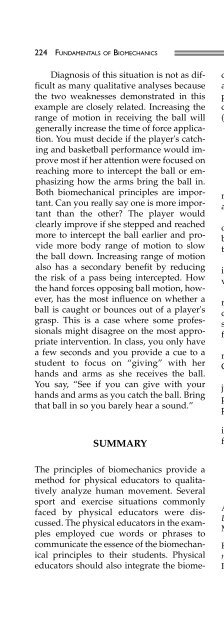Fundamentals of Biomechanics
Fundamentals of Biomechanics
Fundamentals of Biomechanics
You also want an ePaper? Increase the reach of your titles
YUMPU automatically turns print PDFs into web optimized ePapers that Google loves.
224 FUNDAMENTALS OF BIOMECHANICS<br />
Diagnosis <strong>of</strong> this situation is not as difficult<br />
as many qualitative analyses because<br />
the two weaknesses demonstrated in this<br />
example are closely related. Increasing the<br />
range <strong>of</strong> motion in receiving the ball will<br />
generally increase the time <strong>of</strong> force application.<br />
You must decide if the player's catching<br />
and basketball performance would improve<br />
most if her attention were focused on<br />
reaching more to intercept the ball or emphasizing<br />
how the arms bring the ball in.<br />
Both biomechanical principles are important.<br />
Can you really say one is more important<br />
than the other? The player would<br />
clearly improve if she stepped and reached<br />
more to intercept the ball earlier and provide<br />
more body range <strong>of</strong> motion to slow<br />
the ball down. Increasing range <strong>of</strong> motion<br />
also has a secondary benefit by reducing<br />
the risk <strong>of</strong> a pass being intercepted. How<br />
the hand forces opposing ball motion, however,<br />
has the most influence on whether a<br />
ball is caught or bounces out <strong>of</strong> a player's<br />
grasp. This is a case where some pr<strong>of</strong>essionals<br />
might disagree on the most appropriate<br />
intervention. In class, you only have<br />
a few seconds and you provide a cue to a<br />
student to focus on “giving” with her<br />
hands and arms as she receives the ball.<br />
You say, “See if you can give with your<br />
hands and arms as you catch the ball. Bring<br />
that ball in so you barely hear a sound.”<br />
SUMMARY<br />
The principles <strong>of</strong> biomechanics provide a<br />
method for physical educators to qualitatively<br />
analyze human movement. Several<br />
sport and exercise situations commonly<br />
faced by physical educators were discussed.<br />
The physical educators in the examples<br />
employed cue words or phrases to<br />
communicate the essence <strong>of</strong> the biomechanical<br />
principles to their students. Physical<br />
educators should also integrate the biome-<br />
chanical principles with their experience,<br />
as well as knowledge from other subdisciplines<br />
<strong>of</strong> kinesiology to provide an interdisciplinary<br />
approach to qualitative analysis<br />
(Knudson & Morrison, 2002).<br />
DISCUSSION QUESTIONS<br />
1. What biomechanical principles are<br />
more important in kicking versus trapping<br />
a soccer ball?<br />
2. What are the typical teaching points<br />
or cues for baseball/s<strong>of</strong>tball batting? What<br />
biomechanical principles are relevant in<br />
these teaching points?<br />
3. How is the application <strong>of</strong> biomechanical<br />
principles different in the free throw<br />
versus the jump shot?<br />
4. Which biomechanical principles are<br />
relevant to the pushup exercise? How does<br />
changing hand position from a wide base <strong>of</strong><br />
support to a narrow base <strong>of</strong> support modify<br />
the importance <strong>of</strong> these principles?<br />
5. What biomechanical principles are<br />
most relevant to catching a s<strong>of</strong>tball?<br />
Catching a medicine ball?<br />
6. What are typical teaching points in<br />
jumping to rebound a basketball? What<br />
points are most important based on the<br />
principles <strong>of</strong> biomechanics?<br />
7. What biomechanical principles are<br />
important in throwing a pass in American<br />
football?<br />
SUGGESTED READING<br />
Adrian, M. J., & Cooper, J. M. (1995).<br />
<strong>Biomechanics</strong> <strong>of</strong> human movement (2nd ed.).<br />
Madison, WI: Brown & Benchmark.<br />
Hay, J. G. (1993). The biomechanics <strong>of</strong> sports techniques<br />
(4th. ed.). Englewood Cliffs, NJ:<br />
Prentice-Hall.






